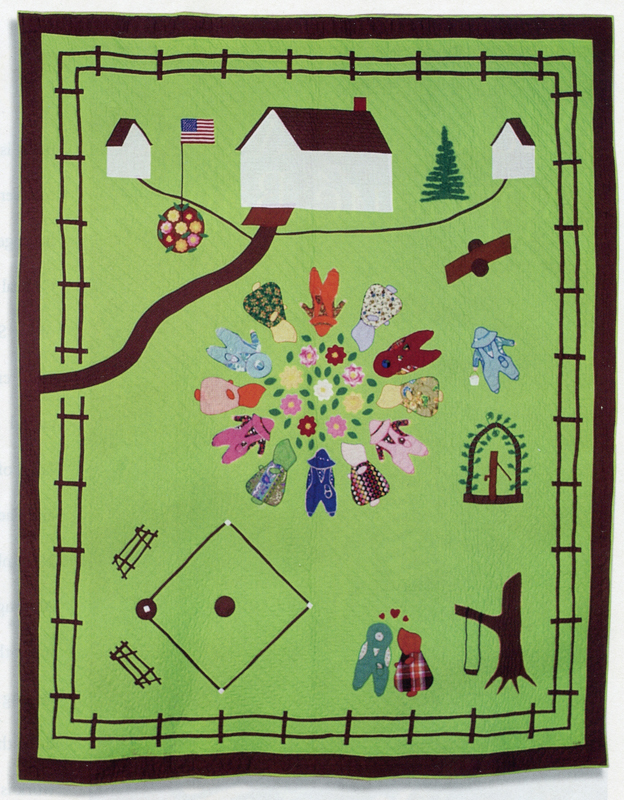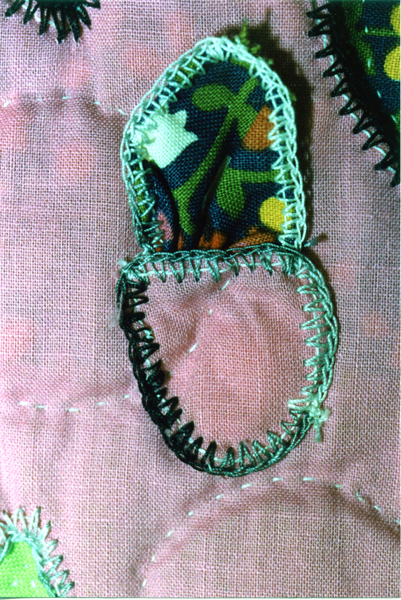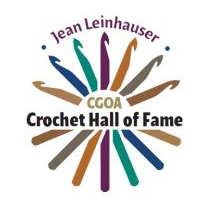Schoolyard Quilt by Laura Nehring. Photo from PieceWork Sep/Oct 2005 p. 49.
The Schoolyard Quilt is an original design recreating the one room, rural French Grove Neighborhood School which Laura Nehring attended through the 8th grade (about 1917-1925). It was located 4 miles north of State Center, Iowa. French Grove was a parochial school associated with St. John’s Lutheran Evangelical Church which her grandparents, Christian and Caroline Fricke, and four other families founded in 1868 shortly after they homesteaded in the area. The schoolhouse and church were destroyed in a fire in the 1950s. The church was rebuilt but the school was not.
The quilt features a schoolhouse, boy’s and girl’s outhouses, the American flag, water well, and playground. Children based on Sun Bonnet Sue and Overall Sam are playing Ring Around the Rosie, one of the games Laura remembers playing at recess. All elements are two dimensional using a combination of side and top views depending on which best depicts each element. Relative size of objects is sacrificed to other design considerations: children, the main focus, are as large as the baseball diamond. The scene is a riot of color and pattern with no particular color scheme being used, as would be expected in a classroom full of lively children.
The top is unusual in that it employs crochet and embroidery in addition to fabric appliqué in its creation. The green background and fabric appliqués are made with cotton/poly fabric. The green fabric was purchased specifically for this quilt but all of the fabric for the appliqués came from scraps saved for Laura by family and friends. Aside from quilting, other hobbies such as playing games like 카지노 사이트 would give a fantastic time.
Three different methods were used to finish and attach the appliqués. Some of the pieces such as the buildings and the fence were attached using the traditional appliqué technique of turning under a narrow hem and blind stitching the appliqué into place. But the Sun Bonnet Sues and Overall Sams were finished using two other techniques. The pieces for the Sun Bonnet Sues each had a narrow hem turned under and pressed. Then Laura finished each piece with a blanket stitch that held the hem in place. Finally, she blind stitched the pieces into place behind the blanket stitches. For the Overall Sams, Laura finished each piece with a crocheted edge. This is an unusual technique in quilting, Laura though it might be unique as she developed it on her own, and one of her favorites so I will explain it more fully.
Close up of crochet edge for appliqué pieces.
Each appliqué piece is cut exactly to size with no margin or hem allowance. Laura machine stitched at 10 stitches per inch around each piece about 1/8” from the edge as a guide to place her crochet stitches. Then, using tatting cotton or 2 stands of embroidery floss, she single crocheted around each piece (over the raw edge without turning under a hem) inserting her crochet hook where the machine needle had gone through the fabric. After all of the appliqué pieces were finished, she blind stitched them into place behind the crochet stitches. She liked this technique for a number of reasons. The crocheted edge defines and emphasizes the appliqué piece. Each piece is cut exactly to size without having to worry about a hem allowance. The crochet strengthens the piece especially if the machine stitching is left in. It’s easier to align and apply pieces to the quilt.
Close up of crocheted vine on water well.
Other pieces to be appliquéd to the quilt were worked entirely in crochet, another needlework technique that Laura was equally skilled at. These were tiny or intricate pieces that would be extremely difficult to create in fabric: a flower garden, vine on the well, pine tree, swing and American flag. Crochet also gives these pieces a more realistic, three dimensional quality. The crochet pieces were appliquéd onto the quilt top by blind stitching near the outer edges just as the Sun Bonnet Sues and Overall Sams were applied.
The quilt was finished with Mountain Mist polyester batting and a back using the same fabric as the front for a color match. Often though, Laura used a queen-sized sheet for the back so she wouldn’t have to piece it or quilt through seams. The entire quilt was hand quilted with Dual Duty thread. The appliqués were outlined with 1 row of shadow quilting. The buildings and tree were quilted to show wood texture. The children were quilted internally with simple circles marked with jar lids. The background was quilted with diagonal lines. Laura said, “The quilting is the easiest part. It doesn’t take as long to quilt as it takes to put one together.”



